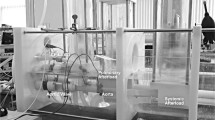Abstract
This model study evaluates the effect of pump characteristics and cardiovascular data on hemodynamics in atrio–aortic VAD assistance. The model includes a computational circulatory sub-model and an electrical sub-model representing two rotary blood pumps through their pressure–flow characteristics. The first is close to a pressure generator—PG (average flow sensitivity to pressure variations, −0.047 l mmHg−1); the second is closer to a flow generator—FG (average flow sensitivity to pressure variations, −0.0097 l mmHg−1). Interaction with VAD was achieved by means of two interfaces, behaving as impedance transformers. The model was verified by use of literature data and VAD onset conditions were used as a control for the experiments. Tests compared the two pumps, at constant pump speed, in different ventricular and circulatory conditions: maximum ventricular elastance (0.44–0.9 mmHg cm−3), systemic peripheral resistance (781–1200 g cm−4 s−1), ventricular diastolic compliance C p (5–10–50 cm3 mmHg−1), systemic arterial compliance (0.9–1.8 cm3 mmHg−1). Analyzed variables were: arterial and venous pressures, flows, ventricular volume, external work, and surplus hemodynamic energy (SHE). The PG pump generated the highest SHE under almost all conditions, in particular for higher C p (+50 %). PG pump flow is also the most sensitive to E max and C p changes (−26 and −33 %, respectively). The FG pump generally guarantees higher external work reduction (54 %) and flow less dependent on circulatory and ventricular conditions. The results are evidence of the importance of pump speed regulation with changing ventricular conditions. The computational sub-model will be part of a hydro-numerical model, including autonomic controls, designed to test different VADs.




Similar content being viewed by others
References
Meyns B, Klotz S, Simon A, Droogne W, Rega F, Griffith B, Dowling R, Zucker MJ, Burkhoff D. Proof of concept: hemodynamic response to long-term partial ventricular support with the synergy pocket micro-pump. J Am Coll Cardiol. 2009;54:79–86.
Umezu M, Yamazaki K, Ymazaki S, Iwasaki K, Miyakoshi T, Kitano T, Tokuno T. Japanese-made implantable centrifugal type ventricular assist system (LVAS): EVAHEART. Biocybern Biomed Eng. 2007;27:111–9.
Bartley PG, Kormos RL, Borovetz HS, Litwak K, Antaki JF, Poirier VL, Butler KC. HeartMate II left ventricular assist system: from concept to first clinical use. Ann Thorac Surg. 2001;71:S116–20.
Zhou J, Armstrong GP, Medvedev AL, Smith WA, Golding LA, Thomas JD. Numeric modeling of the cardiovascular system with a left ventricular assist device. ASAIO J. 1999;45:83–9.
Shi Y, Korakianitis T. Bowles C numerical simulation of cardiovascular dynamics with different types of VAD assistance. J Biomech. 2007;40:2919–33.
Knierbein B, Reul H, Eilers R, Lange M, Kaufmann R, Rau C. Compact mock loops of the systemic and pulmonary circulation for blood pump testing. Int J Artif Organs. 1992;15:40–8.
Ferrari G, Kozarski M, De Lazzari C, Clemente F, Merolli M, Tosti G, Guaragno M, Mimmo R, Ambrosi D, Głapinski J. A hybrid (numerical-physical) model of the left ventricle. Int J Artif Organs. 2001;24:456–62.
Colacino FM, Arabia M, Danieli GA, Moscato F, Nicosia S, Piedimonte F, Valigi P, Pagnottelli S. Hybrid test bench for evaluation of any device related to mechanical cardiac assistance. Int J Artif Org. 2005;28:817–26.
Gwak KW, Paden BE, Antaki JF, Ahn IS. Experimental verification of the feasibility of the cardiovascular impedance simulator. IEEE Trans Biomed Eng. 2010;57:1176–83.
Ferrari G, Kozarski M, Zieliński K, Fresiello L, Di Molfetta A, Górczyńska K, Pałko KJ, Darowski M. A modular computational circulatory model applicable to VAD testing and training. J Artif Organs. 2011;15:32–43.
Ferrari G, Kozarski M, Gu YJ, De Lazzari C, Di Molfetta A, Pałko KJ, Zieliński K, Górczyńska K, Darowski M, Rakhorst G. Application of a user friendly comprehensive circulatory model for hemodynamic and ventricular variables estimate. Int J Artif Organs. 2008;31:1043–54.
Di Molfetta A, Santini L, Forleo G, Minni V, Mafhouz K, Della Rocca D, Fresiello L, Romeo F, Ferrari G. Towards a personalized and dynamic CRT-D: a computational cardiovascular model dedicated to therapy optimization. Methods Inform Med. 2012. doi:http://dx.doi.org/10.3414/ME12-01-0011.
Kozarski M, Ferrari G, Zieliński K, Górczyńska K, Pałko KJ, Tokarz A, Darowski M. A new hybrid electro-numerical model of the left ventricle. Comput Biol Med. 2008;38:979–89.
Fresiello L, Khir AW, Di Molfetta A, Kozarski M and Ferrari G. Effects of Iabp timing on baroreflex activities in a closed loop cardiovascular hybrid model. Artif Organs. 2012. doi:10.1111/j.1525-1594.2012.01540.x.
Linear circuits applications: voltage to current converters. In: Graeme JG, Tbey GE, Huelsman LP, editors. Operational amplifiers. Design and applications. Tokyo: McGraw–Hill International; 1981. p. 225–9.
Ündar A, Ji B, Lukic B, Zapanta C, Kunselman AR, Reibson JD, Weiss WJ, Rosenberg G, Myers JL. Quantification of perfusion modes in terms of surplus hemodynamic energy levels in a simulated pediatric CPB model. ASAIO J. 2006;52:712–7.
Moscato F, Vollkron M, Bergmeister H, Wieselthaler G, Leonard E, Schima H. Left ventricular pressure–volume loop analysis during continuous cardiac assist in acute animal trials. Artif Organs. 2007;31:369–76.
Kawaguchi O, Sapirstein JS, Daily WB, Pae WE, Pierce WS. Left ventricular mechanics during synchronous left atrial–aortic bypass. J Thorac Cardiovasc Surg. 1994;107:1503–11.
Kozarski M, Ferrari G, Zielinski K, Górczynska K, Palko KJ, Fresiello L, Di Molfetta A, Darowski M. A hybrid (hydro-numerical) cardiovascular model application to investigate continuous-flow pump assistance effect. Biocybern Biomed Eng. 2012;32:77–91.
SensorART. A remote controlled Sensorized ARTificial heart enabling patients empowerment and new therapy approaches—Integrated Project funded within the framework of the European Community’s Seventh Framework Programme (FP7/2007-2013) under grant agreement no. 248763 (http://www.sensorart.eu).
Acknowledgments
This work was supported by European Union (EU) Integrated Project SensorART (Grant Number: 248763).
Author information
Authors and Affiliations
Corresponding authors
Rights and permissions
About this article
Cite this article
Ferrari, G., Kozarski, M., Fresiello, L. et al. Continuous-flow pump model study: the effect on pump performance of pump characteristics and cardiovascular conditions. J Artif Organs 16, 149–156 (2013). https://doi.org/10.1007/s10047-013-0691-7
Received:
Accepted:
Published:
Issue Date:
DOI: https://doi.org/10.1007/s10047-013-0691-7




